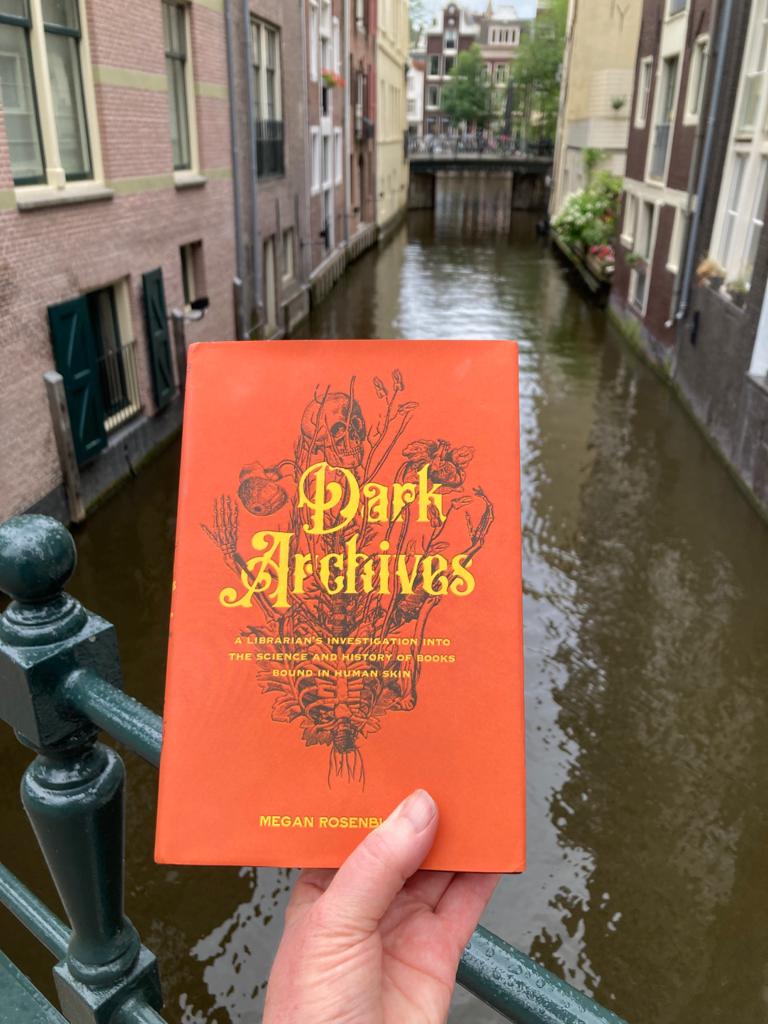One thing I like about the field of Death Studies is that there are always new things to learn about, and to discover interesting, albeit obscure, phenomena I had never heard of, or considered to be ‘a thing’. Librarian Megan Rosenbloom’s book Dark Archives: a librarian’s investigation into the science and history of books bound in human skin is a prime example of such a phenomenon. Prior to reading this wonderfully morbid book, I had no idea that there are books bound in actual human skin. I have enjoyed telling people I was reading this book, and reactions have predominantly been that of disgust and horror. This might speak to my general interest in death, but when I first heard about this book my initial reaction was “Sure, why not?”
Dark Archives is a fascinating account of Rosenbloom research on anthropodermic books, or books bound in human skin (From the Latin anthropos= human and derma=skin). Rosenbloom was curious both in books bound in human skin as well as the myths and stories surrounding books claimed to be bound in human skin. While many of the alleged skin books turn out to be bound in horse, sheep, rabbit or other types of animal skin, the practice of bookbinding as well as the reasons why people claimed books were bound in human skin are equally captivating.
“Sometimes the most unlikely candidates turn out to be real human skin, and some books with plausible pedigrees turn out to be frauds. As of this writing my team has identified only about fifty alleged anthropodermic books in public collections and a few more in private hands. With such as small field of study, any test result could completely reshape our understanding or the scope of this practice. We have to approach every item objectively and let the science out the truth”
— Dark Archives. Page:9
Recent technologies have made it possible to test alleged human skin books. Despite only needing a small sample of a book, not all alleged books can be tested without damaging the book. Some book owners also do not want their books to be tested, as they fear the repercussions of owning a ‘real’ book.
Books bound in human skin spark interesting ethical dilemmas about ownership of dead bodies, and notions of informed consent. Rosenbloom’s research shows, however, that historically consent was rarely forthcoming or sought from those who ended up on someone’s bookshelf. Exceptionally, Rosenbloom outlines the case of William Corder, a person in prison who requested his skin to be used to bind books when he knew he was dying. But he is the only know case of someone making this request, and the majority of human-skin-bound books have an iffy history.
Rosenbloom shows the dubious role medical practitioners played in this practice as they often were the owners of such books and the ones ‘yielding the knife’. The distant medical gaze which views dead bodies as objects to be used in artefacts, which makes human-skin-bound books possible, highlights how our present day understanding of consent in medical encounters, both prior and post-death, are very recent phenomena.
The existence of human-skin-bound books offers an opportunity to think about how different social and cultural environments treat dead bodies, and what you can and cannot do with a body post-death. The status of anthropodermic books is highly determined by the legal environment or, in other words, the geographical context in which they reside.
““In the U.K. there’s a legal distinction between human remains and an object made using human remains “through the application of skill,” a distinction usually referring to tribal objects, but that would also apply to a human-skin-bound book. In this view, a skeleton is deemed human remains but an anthropodermic book would be considered a cultural artifact””
— Dark Archives. Page:193
This distinction made in the UK is not part of any US-based law and thus provides a different starting point on how these books are treated and viewed. Typically, the law surrounding dead bodies is very vague as societies around the globe are uncertain of the status of dead bodies. This all begs the question: if it is not illegal to use human skin in bookbinding, would you like your skin to be used for this purpose post-death? Or, if these books were for sale, would you buy one?
Walking past the American Book Center in Amsterdam, I noticed a flyer for an upcoming virtual event with Megan Rosenbloom, September 17, 19:30-20:30 (Amsterdam Time). Click here for more information.


Leave a Reply